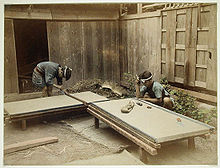Tatami

A tatami (畳) is a type of mat used as a flooring material in traditional Japanese-style rooms. Traditionally made of rice straw to form the core (though nowadays sometimes the core is composed of compressed wood chip boards or polystyrene foam), with a covering of woven soft rush (igusa) straw, tatami are made in uniform sizes. Usually, on the long sides, they have edging (heri) of brocade or plain cloth, although some tatami have no edging.[1]
Contents |
[edit] History
The term tatami is derived from the verb tatamu, meaning to fold or pile. This indicates that the early tatami were thin and could be folded up when not used or piled in layers.[2] Tatami were originally a luxury item for the nobility. During the Heian period, when the shinden-zukuri architectural style of aristocratic residences was consummated, the flooring of shinden-zukuri palatial rooms were mainly wooden, and tatami were only used as seating for the highest aristocrats.[3] In the Kamakura period, there arose the shoin-zukuri architectural style of residence for the samurai and priests who had gained power. This architectural style reached its peak of development in the Muromachi period, when tatami gradually came to be spread over whole rooms, beginning with small rooms. Rooms completely spread with tatami came to be known as zashiki (lit., room spread out for sitting), and rules concerning seating and etiquette determined the arrangement of the tatami in the rooms.[4] It is said that prior to the mid-16th century, the ruling nobility and samurai slept on tatami or woven mats called goza, while commoners used straw mats or loose straw for bedding.[5]
The lower classes had mat-covered dirt floors.[6]
Tatami were gradually popularized and finally reached the homes of commoners toward the end of the 17th century.[7]
Houses built in Japan today often have very few tatami-floored rooms, if any. Having just one is not uncommon. The rooms having tatami flooring and other such traditional architectural features are referred to as nihonma or washitsu, "Japanese-style rooms".
[edit] Size
The size of tatami differs between different regions in Japan. In the Kyoto area, tatami generally measure .955 m by 1.91 m. Tatami of this size are referred to as Kyōma tatami. Tatami in the Nagoya region generally measure .91 m by 1.82 m, and are referred to as ainoma (lit., "in-between" size) tatami. In the region around Tokyo, tatami generally measure .88 m by 1.76 m. Tatami of this size are referred to as Edoma or Kantōma tatami. In terms of thickness, 5.5 cm is average for a Kyōma tatami, while 6.0 cm is the norm for a Kantōma tatami.[8] A half mat is called a hanjō, and a mat of three-quarter length, which is used in tea-ceremony rooms (chashitsu), is called daimedatami.[9]
In Japan, the size of a room is typically measured by the number of tatami mats (-畳 -jō).
Tatami in the Nagoya region are based on the English measurement system.[citation needed] The metric measurement .91 m by 1.82 m is about 2′11.83″ by 5′11.65″, which can be rounded to 3 ft × 6 ft. Some common room sizes are (in the Nagoya region):
- 4½ mats ≈ 9 ft × 9 ft
- 6 mats ≈ 9 ft × 12 ft
- 8 mats ≈ 12 ft × 12 ft
Shops were traditionally designed to be 5½ mats[citation needed], and tea rooms are frequently 4½ mats.
[edit] Layout
There are rules concerning the number of tatami mats and the layout of the tatami mats in a room. In the Edo period, "auspicious" tatami arrangements and "inauspicious" tatami arrangements were distinctly differentiated, and the tatami accordingly would be rearranged depending on the occasion. Nowadays, the "auspicious" layout is ordinarily used. In this arrangement, the junctions of the tatami form a "T" shape; in the "inauspicious" arrangement, the tatami are in a grid pattern wherein the junctions form a + shape.[8]
An inauspicious layout is said to bring bad fortune. In homes, the mats must not be laid in a grid pattern, and in any layout there is never a point where the corners of four mats touch.
[edit] Use

Tatami mats in Japanese culture are flooring surfaces to be kept as clean as a bed surface or dining table surface. Nowadays, they are commonly associated with Japanese religious rites and the tea ceremony. Most modern Japanese homes still have at least one tatami room, the washitsu which is furnished and decorated in the traditional Japanese style.
Tatami are also used when training in Japanese martial arts, such as judo, for protective purposes.
Tatami "omote", or the outside rush mat layer, wrapped over the rice straw core of the mat, is used in the practice of tameshigiri in Japanese swordsmanship. The tatami omote mats are rolled into cylinders, soaked in water for several days, and then cut in order to test either a newly made sword's sharpness or a swordsman's skill.
[edit] See also
[edit] Notes
- ^ Japanese wikipedia "tatami" article
- ^ Kodansha Encyclopedia of Japan, entry for "tatami."
- ^ Sato Osamu, "A History of Tatami," in Chanoyu Quarterly no. 77 (1994)
- ^ Sato Osamu, "A History of Tatami," in Chanoyu Quarterly no. 77 (1994)
- ^ Kodansha Encyclopedia of Japan, entry for "bedding"
- ^ "The Yoshino Newsletter". "Floors/Tatami". Yoshino Japanese Antiques. http://www.yoshinoantiques.com/Interior-article.html. Retrieved 2007-03-28.
- ^ "Kyoto International Community House Newsletter". 2nd section titled History of tatami. Kyoto City International Foundation. http://www.kcif.or.jp/en/newsletter/lik/archives/0304/04_2003.htm. Retrieved 2007-03-28.
- ^ a b Sato Osamu, "A History of Tatami," in Chanoyu Quarterly no. 77 (1994).
- ^ Kodansha Encyclopedia of Japan, entry for "tatami."
[edit] External links
| Wikimedia Commons has media related to: Tatami |
- Tatamit information on tatami in Finnish
|
|||||||||||||||||||||||||||||||||||||


